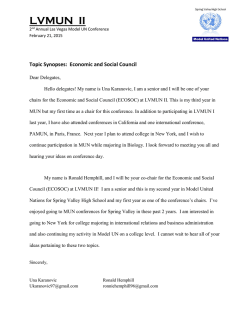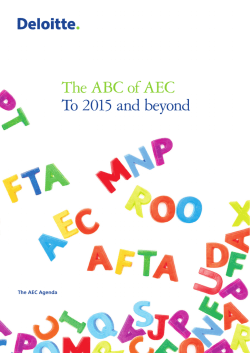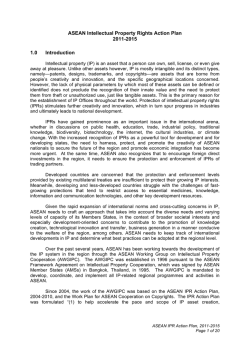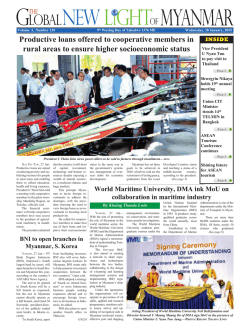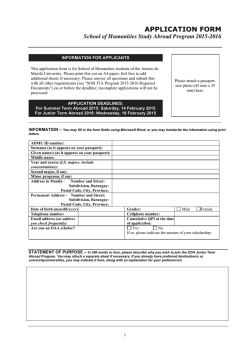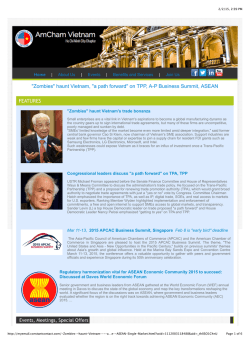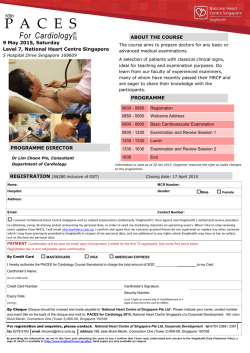
View PDF
ISSN 2335-6677 #4 2015 Singapore | 29 Jan 2015 The ASEAN Economic Community: An Economic and Strategic Project By Sanchita Basu Das EXECUTIVE SUMMARY • The ASEAN Economic Community (AEC) is both an economic and strategic initiative. • As an economic project, the AEC is expected to achieve its objective of a single market by end-2015. Although ASEAN has achieved 82.1 per cent of its targets, it has not yet reached its end-goal since both border and beyond-the-border restrictions continue to prevail in the region. The elimination of such restrictions is likely to be the most important task if ASEAN intends to move towards a single market space in the future. • As a strategic project, the AEC is conceived to help member states pursue their national interests. Economic cohesion is expected to help the 10 small economies during times of economic vulnerabilities, to deliver on a bigger market space of 600 million people to attract FDI, and to play the role of a ‘hub’ in the larger Asian region. • In addition, economic coherence is likely to strengthen the member states’ bargaining power in the WTO and in their collective negotiating position for FTAs and other strategic matters. 1 • The AEC’s achievement as a strategic project can be observed in ASEAN states’ increasing level of FDI; cooperative stance during the 2008 crisis; positive behaviour in dealing with the international community; and increasing belief in maintaining centrality. • Going forward, the AEC process will continue, not just for its economic benefits of lowering trade and investment costs in the region, but also for managing ongoing economic and geopolitical uncertainties. * Sanchita Basu Das is ISEAS Fellow and Lead Researcher (Economic Affairs) at the ASEAN Studies Centre, ISEAS, Singapore. She is also the coordinator of the Singapore APEC Study Centre. Email: [email protected] 2 INTRODUCTION As we begin 2015, attention turns to the ten Southeast Asian nations and their concrete ‘deliverable’ of an ASEAN Economic Community (AEC) on 31 December. Understandably, questions have been raised as to whether the AEC can be successfully achieved. This paper tries to provide an answer to this by arguing that one should not judge the AEC solely by its economic outcomes and the issue of whether the AEC can be attained in its entirety by the deadline. Rather, one should also evaluate the AEC against its ability to serve the region’s strategic goals of economic coherence in dealing with the international community as well as maintaining ASEAN centrality.1 AEC – AN ECONOMIC PROJECT ASEAN adopted the AEC initiative in 2003 to deliver ‘a stable, prosperous and highly competitive ASEAN economic region in which there is a free flow of goods, services, investment and a freer flow of capital, equitable economic development and reduced poverty and socio-economic disparities in the year 2020’. These are to be achieved by making ASEAN a ‘single market and production base’ and a ‘more dynamic and stronger segment of the global supply chain’.2 The 12th ASEAN Summit in January 2007 agreed to advance the achievement of AEC from 2020 to 2015, and it was widely accepted that ASEAN’s commitment to deeper and well-encompassing integration measures is likely to generate more welfare gains that were achieved through the tariff liberalisation initiatives of the ASEAN Free Trade Area (AFTA) in the 1990s. Indeed, studies undertaking Computable General Equilibrium (CGE)3 modelling and using a broader approach of trade cost4 concluded that ‘AEC could yield benefits amounting to 5.3 per cent of the region’s GDP and more than twice that if the AEC leads to FTAs with key external partners.’5 The AEC is said to have achieved 82.1 per cent of the stipulated targets mentioned in the 2007 Blueprint.6 Truly, this achievement can be considered a significant beginning for ASEAN (Table 1). Under trade in goods, tariffs have been lowered, the ASEAN Single Window is ready, key agreements like the ASEAN Trade in Goods Agreement (ATIGA) and the ASEAN Comprehensive Investment Agreement (ACIA) are in place. In addition, the 1 ASEAN Centrality implies that ASEAN, instead of the bigger economies like those of China, Japan, the US or India, should be the hub of developing a wider Asia-Pacific regional architecture. [Amitav Acharya. (2012) ‘The End of ASEAN Centrality?’ in Asia Times Online, August 8] 2 ASEAN Secretariat (2003), Declaration of ASEAN Concord II (Bali Concord II), Bali, 7 October 2003. (http://www.asean.org/news/item/declaration-of-asean-concord-ii-bali-concord-ii 3 CGE models provide an empirical foundation to trade policies that can quantify the magnitude of the effects identified in the theory of net welfare gain from trade creation and trade diversion. 4 Broader trade costs implies not just removal of tariffs and NTBs but also indirect expenses such as time and uncertainties due to custom clearance, aligning standards and other facilitation measures. 5 Petri, Peter. A, Plummer, Michael and Zhai, Fan (2012) ‘The ASEAN Economic Community: A General Equilibrium Analysis’, Asian Economic Journal, 26(2): 93-118 6 ASEAN Secretariat (2014), Chairman's Statement of the 25the ASEAN Summit: ‘Moving Forward in Unity to a Peaceful and Prosperous Community’, 12 November 2014 3 Master Plan for ASEAN Connectivity (MPAC) has been adopted to reduce business transaction cost as well as time and travel costs in the region. Mutual Recognition Arrangements (MRAs) for seven professions have been signed. These include engineering and architecture, nursing, accountancy and surveying services, medical and dental profession. Furthermore, disparity in per capita income among members has been reduced. Since the beginning of 2000, ASEAN has engaged its major trading partners through Free Trade Agreements (FTAs), and a limited number of private sector firms like Jollibee, Jebsen and Jessen, Denso Corporation, Sony Electronics, L’Oreal, Caterpillar, Prudential Insurance, CIMB bank and Fortis Hospital are also benefiting from ASEAN’s initiatives of liberalisation and facilitation.7 Table 1: Progress towards the ASEAN Economic Community Selected Indicators Year Value Early Year Year Value Trend Latest Year Intra-ASEAN Trade, US$ billion 2000 166.1 2012 602.0 Increasing Intra-ASEAN trade share (%) 2000 22.0 2012 24.3 Increasing Intra-ASEAN FDI Inflows, US$ billion 2000 1.2 2012 20.1 Increasing Intra-ASEAN FDI share (%) 2000 5.1 2012 18.3 Increasing Intra-ASEAN Trade in Services, US$ billion 2005 21.3 2011 44.4 Increasing Intra-ASEAN services trade share (%) 2005 8.1 2011 8.4 Increasing 2000 4187 2012 8394 Increasing ASEAN average of WEF Competitiveness index (as % of the first ranked country) 2000 77.7 2011 80.6 Increasing ASEAN average of Human Development Index 2005 0.635 2013 0.690 Increasing ASEAN GDP per capita (PPP$), average a Note: a- the per capita average is calculated based on IMF world economic outlook database and excludies the figures for Brunei and Singapore (their GDP per capita in PPP term is more than $75,000 in 2012). Source: Author’s modification, using ASEAN Community Progress Monitoring System, The ASEAN Secretariat, 2012 7 ASEAN Community Progress Monitoring System, The ASEAN Secretariat, 2012; Economic Research Institute for ASEAN and East Asia (ERIA), 2012, ‘Mid-term Review of the ASEAN Economic Community Blueprint’; discussion with ASEAN Secretariat officials. 4 Despite these outcomes, ASEAN is far from its goal of attaining a single market and production base8. There are a number of hurdles. First, non-tariff barriers (NTBs) in the form of non-automatic licensing, technical regulations and quality standards continue to prevail in the region. Second, the region continues to suffer from infrastructure deficiency. These two factors together negate the full benefit from tariff liberalization. Third, despite negotiations over the past fifteen years, there is only a marginal liberalization in the services sector. This is attributed to the lack of policy alignment between the regional and domestic economies. For example, although MRAs for seven professions have been signed, many countries impose domestic restrictions on foreign nationals or nonresidents working as professionals. Fourth, the region continues to experience difficulties from the development gaps among its member economies. These disparities span: human resources; economic institutions; the incidence of poverty, physical infrastructure; finance; and information and communication technology.9 This hampers the Foreign Direct Investment (FDI) flows into member countries. While FDI inflows have gone up from US$21.8 billion in 2000 to US$110.3 billion in 2012 for the ASEAN region as a whole, they have mostly gone to Singapore. In addition to the regional initiative, the city-state offers the most business friendly environment to foreign investors (Table 2).10 8 Sanchita Basu Das. (2012) ‘Can the ASEAN Economic Community be Achieved by 2015?’ ISEAS Perspective, Singapore: Institute of Southeast Asian Studies, 11 October. 9 Salazar, Lorraine C and Basu Das, Sanchita (2007) ‘Bridging the ASEAN Development Divide: Challenges and Prospects’ in Lorraine C. Salazar and Sanchita B. Das (eds) ASEAN Economic Bulletin (Special Issue), 24 (1), pp. 1-14) 10 For a detailed discussion on Investment Climate in ASEAN, please refer to Urata, Shujiro and Mitsuyo A. ‘Investment Climate Study on ASEAN Member Countries’. ERIA Publication, March 2011 and Bhaskaran, Manu. ‘The ASEAN Economic Community: The Investment Climate’ in Sanchita Basu-Das, Jayant Meanon, Rodolfo Severino and Omkar Lal Shrestha (eds).The AEC: A Work in Progress. 5 Table 2: Attractive of ASEAN member countries and Inward FDI Flows Ranking in Logistics Performance Index, 2014* Ranking in Ease of Doing Business, 2012** Ranking in Global Competitiveness Index, 2012-13*** Value of FDI, US$ billion (Share in ASEAN FDI Flows, %), 2010-12 Brunei -- 83 28 9.1 (1.2) Cambodia 83 138 85 6.9 (0.9) Indonesia 53 129 50 81.1 (11.0) Laos 131 165 -- 2.1(0.3) Malaysia 25 18 25 72.5 (9.8) Myanmar 145 -- -- 9.9 (1.3) Philippines 57 136 65 22.3(3.0) Singapore 5 1 2 382.5 (51.7) Thailand 35 17 38 93.9 (12.7) Vietnam 48 98 75 59.1 (8.0) Total ASEAN -- -- -- 739.5 (100.0) Note: *- out of 160 countries; **- out of 183 economies; ***- out of 144 countries Source: Logistics Performance Index 2014, Doing Business 2012, World Bank; World Competitiveness Index, 2012-2013; The ASEAN Statistical Yearbook, 2013, The ASEAN Secretariat. These issues imply that, although ASEAN has achieved a significant percentage of its stipulated targets, it has not yet achieved its objective of constructing a single market. Of all the issues raised, the elimination and harmonization of the NTBs are likely to be the most important tasks if ASEAN intends to move towards its goal of a single market in the future. However, the success of economic regionalism should not be judged solely on economic outcomes, as countries decide to join a regional grouping such as ASEAN and the AEC for a variety of reasons. To understand the AEC, it is also important to understand the strategic rationale. AEC – A STRATEGIC PROJECT Dr. Mari Pangestu, Minister of Trade of Indonesia from 2004-2011, stated that ASEAN’s economic cooperation is ‘more for foreign policy and strategic reasons than for economic 6 reasons’11. For example, AFTA was established in the early 1990s to provide a new political purpose to Southeast Asia after the end of US-Soviet confrontation and the Cambodian crisis.12 The context that provided the impetus for AEC, which came in the early 2000s, is also interesting. First, the Asian Financial Crisis (AFC) of 1997-98 had caused havoc in financial systems and a slump in the real economy. ASEAN was in need of a collective economic mechanism to steer it through the crisis, and sought the creating of a ‘public good’ through regional economic cooperation.13 Second, the crisis made ASEAN countries aware of their own limitations. Furthermore, as they were already trading extensively with the Northeast Asian economies, they broadened their economic cooperation to the Asian region14,15 (Table 3). For example, the ASEANChina FTA was the first such initiative signed in 2002 and that was followed by similar agreements with Japan, India, Australia-New Zealand and South Korea. It was argued that ASEAN undertook the initiative to deepen economic cooperation using AEC as it was expected to play the role of a ‘hub’ among its FTA partners, which is a strategic position for the regional organization. Table 3: Share of ASEAN Trade, 2013 Intra-ASEAN Trade Extra-ASEAN Trade ASEAN+3 ASEAN+6 1995 20.1 79.9 45.2 48.2 2001 22.1 77.9 47.6 52.0 2013 24.2 75.8 53.2 59.0 Note: ASEAN+3 includes ten ASEAN and China, Japan and South Korea; ASEAN+6 includes ASEAN+3 members and India, Australia and New Zealand. Source: ASEAN Community in Figures, Special Edition, 2014, The ASEAN Secretariat 11 Pangestu, M. (1995). ‘Indonesia in a Changing World Environment: Multilateralism vs Regionalism’, The Indonesian Quarterly, XXIII (2):121-37. 12 Buszynski, L. (1997) ‘ASEAN’s New Challenges’, Pacific Affairs, 70(2): 555-77. 13 Naya, Seji F. and Plummer, Michael G. (2005). The Economics of the Enterprise for the ASEAN Initiative, Singapore: Institute of Southeast Asian Studies, pp: 360-410. 14 Besides economic cooperation, ASEAN also has financial cooperation with China, Japan and Korea - the Chiang Mai Initiative (CMI), economic surveillance and policy dialogue, and the Asian bond market development initiative - after the 1997-98 crisis. 15 Kawai, M (2005) ‘East Asian Economic Regionalism: Progress and Challenges’, Journal of Asian Economies, 16(1), pp: 29-55. 7 Third, the AEC was thought to be the most logical extension of the various economic initiatives that ASEAN undertook in the 1990s.16 This is because from 1995 to 1999, ASEAN expanded its membership to CLMV countries17 and in the process uncovered the serious development gaps in the region. The AEC was expected to provide a ‘fresh’ comprehensive framework, building on agreements that were already being signed by the member countries in the 1990s18 and would also look into capacity building exercise of the new members. Fourth, in 2001, as China became a member of the World Trade Organisation (WTO) and was fast growing as a target for market and production base, ASEAN leaders grew concerned about investment diversion away from ASEAN to China. Indeed, a significant diversion was already underway in the 1990s19 (Figure 1). This made ASEAN realise that it was necessary to deepen integration among member countries and provide economies of scale to foreign investors. Figure 1: FDI Inflows to China and ASEAN, 1980-2013 Source: UNCTAD 16 Soesastro, H. (2005), ‘ASEAN Economic Community: Concepts, Costs and Benefits’, in Denis Hew (eds), Roadmap to an ASEAN Economic Community, Singapore: Institute of Southeast Asian Studies, pp. 13-30 17 CLMV countries are Cambodia, Laos, Myanmar and Vietnam 18 The agreements of the 1990s were the CEPT scheme in 1993, AFAS in 1995 and AIA in 1998 19 Hew, D; Sen, R; Lee, Poh Onn; Sellakumaran, M; Montreevat, S and Jin, Nigam K (2005) ‘ISEAS Concept Paper on the ASEAN Economic Community’ in Denis Hew (Eds) Roadmap to an ASEAN Economic Community, Singapore: Institute of Southeast Asian Studies 8 Lastly, ASEAN’s initiative to move towards the AEC can also be viewed as a defensive response to the proliferation of regionalism, especially in the Europe and the US. Moreover, there was dissatisfaction with the slow progress of the WTO-Doha liberalisation process and the limited success of the Asia-Pacific Economic Cooperation (APEC) process too.20 Thus, as a strategic project, AEC is meant to help its member states to pursue their national interests. The ten small economies by becoming economically cohesive are expected to not only work together against systemic economic and financial vulnerability but also to provide a bigger market space of 600 million people to foreign investors, which in turn is likely to raise the participation of the member economies in global production networks. Moreover, an economically cohesive region is likely to strengthen the member states’ bargaining power in WTO and in their collective negotiating position for FTAs and other strategic matters. The financial cooperation mechanism under ASEAN+3 is expected to increase the Asian voice in, and for, global financial management. Is AEC successful in attaining its strategic objective? Although things can be difficult to precisely prove, one can see that ASEAN member states navigated the 2008 Global Financial Crisis relatively smoothly. The member governments acted quickly to adopt measures responding to demands by private individuals and financial institutions.21 Global economic issues and uncertainties are regularly discussed in ASEAN meetings.22 Other than that, ASEAN, while negotiating FTAs with big economies, maintains its unity and works as a hub in the Asian regional architecture.23 The AEC’s success strategically, can also be observed in ASEAN’s positive attitude in dealing with the international community. For instance, in 2010, ASEAN engaged the US through the East Asia Summit (EAS).24 Furthermore, in April 2009, ASEAN as an organisation was invited for the first time to join the world’s leading economies at the Group of 20 (G-20) summit in London. The grouping’s growing recognition can also be seen in the appointment of separate ambassadors to ASEAN.25 20 Kawai, M and Wignaraja, G (2008) ‘Regionalism as an Engine of Multilateralism: A Case for a Single East Asian FTA’, Working Paper Series on Regional Economic Integration, No. 14, Asian Development Bank 21 Asian Development Bank. The Global Economic Crisis: Challenges for Developing Asia and ADB’s Response. Manila: ADB, April 2009 22 ASEAN provides a platform for the Finance Ministers to meet regularly to discuss regional cooperation in finance, which includes ASEAN Surveillance Process and Roadmap to Monetary and Financial Cooperation in ASEAN. They also discuss the ASEAN+3 financial cooperation matters. 23 This can be observed by the way negotiations are done for ASEAN+1 FTAs. China has negotiated its FTA with ASEAN as a grouping, Japan, though concluded negotiating bilateral FTAs first with ASEAN members, subsequently, they were summed-up for a regional ASEAN-Japan FTA. 24 The EAS, an ASEAN-led forum held annually by leaders of, initially, 16 countries in the Southeast Asian region. During the Sixth EAS of 2011, membership expanded to 18 countries including the US and Russia. 25 In June 2010, the US became the first non-ASEAN country to establish a dedicated Mission to ASEAN in Jakarta. Thereafter, three other countries (China, Japan and Korea) also established an exclusive Mission to ASEAN in Jakarta. So far 76 non-ASEAN countries have accredited their Ambassadors to ASEAN (ASEAN Secretary-General Speech, 15 October 2013). 9 Finally, with increased attention from the big economies, there is now emphasis among the members on maintaining ‘ASEAN Centrality’. The concept of centrality is said to have been mostly exercised within initiatives adopted for achieving the economic community.26 In November 2012, ASEAN Leaders announced the Regional Comprehensive Economic Partnership (RCEP), which is expected to bring together all five of the ASEAN+1 FTAs into an integrated regional economic framework (Figure 2). It is believed that RCEP is likely to entrench ASEAN centrality that seems to be challenged by other regional economic cooperation initiatives like APEC, the Trans-Pacific Partnership and the China-Japan-Korea Trilateral FTA.27 Figure 2: ASEAN as a ‘Hub’ in the Bigger Regional Architecture CONCLUSION The AEC outcome should not be seen solely in terms of its objective of a single market and whether it can be a game changer for key economic stakeholders currently present in the region. Rather, the AEC should be viewed also as a strategic project that attracts more FDI, help member countries to participate in global supply chains, and strengthen member countries’ bargaining power in international economic, financial and strategic matters. All 26 Ho, Benjamin (2012) ‘ASEAN’s Centrality in a Rising Asia’ RSIS Working Paper Series, No 249, Singapore: S. Rajaratnam School of International Studies, Nanyang Technological University. 27 Sanchita Basu Das. (2012) ‘RCEP: Going Beyond ASEAN+1 FTAs’ ISEAS Perspective, Singapore: Institute of Southeast Asian Studies, 17 August. 10 these together are expected to help ASEAN become a ‘hub’ in the bigger economic space of Asia, thereby contributing to its objective of maintaining centrality. Going forward, one may ask if ASEAN should continue with its AEC project? The answer is ‘yes’. Since the 2008 Global Financial Crisis, the world economy has been more vulnerable than before. The US may be on a positive growth trajectory, but Western Europe is back in the economic doldrums; Japan’s recovery is faltering, irrespective of Abenomics; and China looks as if it is moving towards a new normal of a lower growth rate of around 7 per cent. Adding to these, the recent plummet in crude oil prices, though good for oil importers, is raising risks for deflationary pressure and possibly of a global recession. Other destabilising factors are still present in and around ASEAN economies. First, Asia contains a group of big powers, including China, India, Russia and Japan (with the US playing a role from across the Pacific). Second, despite the end of the Cold War, issues of non-traditional security28 remain pertinent and have become a new security agenda for ASEAN countries. Third, the issue of China in the South China Sea is ongoing and is bereft of an institutional arrangement for resolution. That said, ASEAN’s economic community efforts will continue as an integral part of the management of the ten small national economies. While domestic issues will always be the priority for political leaders, regional initiatives will be propagated to manage external economies and vulnerabilities. Therefore, of late, it is mentioned by almost all ASEAN policy makers that community building is not a one-off exercise. It is an ongoing process and ASEAN members will continue with their efforts beyond 2015. 28 These are defined as challenges to the well-being of people and states that arise from issues like climate change, infectious disease, natural disaster, irregular migration, food shortages, smuggling of persons, drug trafficking and other forms of transnational crimes and these cannot be addressed directly in FTAs. This definition is used by the Consortium of Non-traditional Security Studies in Asia (NTS-Asia; also see http://www.rsis-ntsasia.org/) 11 ISEAS Perspective is published electronically by the Institute of Southeast Asian Studies, Singapore. Institute of Southeast Asian Studies 30, Heng Mui Keng Terrace Pasir Panjang, Singapore 119614 Main Tel: (65) 6778 0955 Main Fax: (65) 6778 1735 Homepage: www.iseas.edu.sg ISEAS accepts no responsibility for facts presented and views expressed. Responsibility rests exclusively with the individual author or authors. No part of this publication may be reproduced in any form without permission. Comments are welcome and may be sent to the author(s). © Copyright is held by the author or authors of each article. 12 Editorial Chairman: Tan Chin Tiong Managing Editor: Ooi Kee Beng Production Editors: Benjamin Loh, Su-Ann Oh and Lee Poh Onn Editorial Committee: Terence Chong, Francis E. Hutchinson and Daljit Singh
© Copyright 2026
